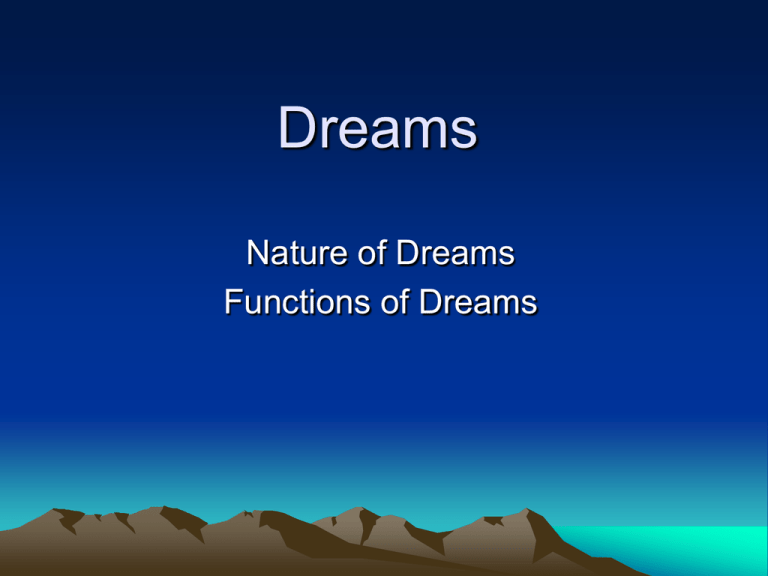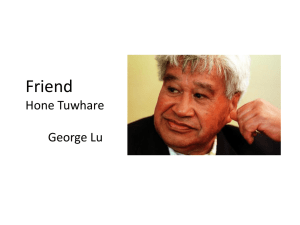
Dreams
Nature of Dreams
Functions of Dreams
Objectives Lesson 1
• To consider key questions in relation to
dreaming.
• To be able to describe common features
of the content and duration of dreams
• To begin to consider the purpose of
dreaming and what different explanations
their might be.
Content of Dreams
• Dreams frequently involve other people & the
dreamer is nearly always personally involved.
• Kahn et al (2000) found that half the characters
in dreams were known to the dreamer, about a
third were more generic characters. Fewer than
one in six were completely unknown or novel.
• Dreams have an emotional content. PET scans
taken during REM sleep show that the brain
regions most associated with emotions are very
active.
Content of Dreams
• Evidence for gender differences show that males
dream about other males more than females
dream of males (Martin, 2002). This appears to
hold across all different cultures & is present in
children & adults (Hall, 1984)
• Cartwright et al (1984) studied 90 people who
were undergoing marital separation & divorce.
Their dream content gave evidence of a strong
correlation .
Different kinds of dream
REM dreams
• Dement & Kleitman (1957) showed that sleepers
who were awoken during REM sleep reported
dreaming 80% of the time.
NREM dreams
• People reported dreams during NREM sleep but
far less (7%). They tend to be shorter, more
mundane and more like fragments of ideas
similar to waking thoughts.
Hypnagogic & Hypnopompic states
• Dream like experiences that occur in the
transitional state between wakefulness and
sleep.
• People who play a lot of computer games
experience ‘screen dreams’ as they fall asleep.
• Pps played tetris for several hours. Many players
later reported vivid dreams about it as they fell
asleep.
Lucid Dreams
Dreamers have self-awareness. Fully aware
of being in a dream and can control the
events taking place.
Dreams are pleasant and straightforward.
Sex is a common theme.
Duration of Dreams
• Every 90 minutes = REM sleep
• Dreams run in ‘real time’, some lasting for
half an hour (Horne,1999)
• Dreams fade rapidly unless awoken
suddenly
• REM dreams vivid relatively long run
through ‘real time’
• NREM mundane short, less intense
Test Yourself
• What do PET scans show about the
content of dreams?
• What did Cartwright’s evidence suggest
about the content of dreams?
• Is it true that time runs slower in dreams?
• What kind of biological rhythm could we
call dream cycles? How long between
each cycle?
Objectives Lesson 2
• To be able to describe Psychological
theories of the function of dreams (Freud
and Cartwright)
• To evaluate these theories
• To be able to use supporting/opposing
evidence to evaluate the theories
Explanations of dreaming
• Psychological theories
(Dreams have meaning)
• Physiological/Neurobiological theories
(Dreams have no meaning)
– Reverse learning (Crick & Mitchison)
– Activation synthesis (Hobson & McCarley)
psychlotron.org.uk
– Ego defence (Freud)
– Problem solving (Cartwright)
Freud and Dreams
• Dreams protect sleeper from irrational urges coming
from id. They allow the release of potentially dangerous
energy which would otherwise lead to insanity.
• Dreams therefore mainly ‘wish fulfullment’
• Dreams nature made up of manifest and latent content.
• Dreams ‘royal road’ into the unconscious mind
Cartwright and Problem Solving
• Cartwright dreams directly reflect our major emotional
concerns
• Problem solving takes place during dreaming—deal with
preoccupations of waking life.
• Dreams provide solutions for work-Kekule and structure
of benzene
• Dreams provide coping strategies for emotional
problems. Mind finds symbols that fit the pressures of
the moment.
Commentary Freud
• Theory difficult to falsify
• Theory based on culturally and historically biased
sample of neurotics Viennese woman.
• However, PET scans show rational brain switched off
during dreaming while forebrain—centre of motivation
memory is fully activated—so no ego but id active.
• Solms shows dreams activated by forebrain not brain
stem.
• Dreamwork - Condensation supported by computer
simulation research.
• Are all dreams wish fulfillments—i.e nightmares?
Commentary on Cartwright
• Barrett 1993 studied students who were
instructed to solve a problem. Over a week a
panel of independent judges found 50% dreamt
a solution.
• Stickgold 2000 found Tetris players dreamt
solutions to problems connected to the game.
• Cartwright 1984 found couples separating had
dreams relating to their waking coping strategies
Objectives Lesson 3
• To be able to describe Neurobiological
theories of the function of dreams
• To evaluate these theories
• To be able to use supporting/opposing
evidence to evaluate the theories
Hobson and McCarley
• Activation-Synthesis. Random internally generated
signals from brainstem are ‘synthesized’ by frontal
cortex.
• Bizarre nature of dreams is the lack of information that
brain does its best to interpret and give meaning.
• Conclusion personal but meaningless.
Crick and Mitchison
• Reverse Learning—we dream to forget.
• Parasitic associations clog up our processing
mechanisms making us function inefficiently
• Dreaming clears out these unwanted memories
• Other unwanted memories are also expelled including
those that might be pathological—that is obsessional.
• Neural networks are kept compact and efficient
Crick and Mitchison
• Reverse Learning—What happens?
• The BRAINSTEM bombards the FOREBRAIN
• This excites the neurons in the FOREBRAIN and
loosens the conections responsible for unnecessary
“parasitic” memories
• Dreams are the “By-product” of this process
Commentary on Neurobiological Theories
• Goertzel 1997 estimates 100 billion billion bits of
information taken in by brain during a lifetime but brain
has only space for 100 billion bits
• Negative correlations between brain size and REM sleep
predicted by theory and found.
• Mammals without REM sleep have larger brains.
• However, Reverse learning can not explain why dreams
are meaningful
• Christos 1996 has shown that computer simulations give
little support for theory
• Capacity of storage for human brain may be
underestimated.
• Pet scans give support to Activation-Synthesis—ie. Brain
stem active prefrontal cortex not active—frontal lobe
active
• Explains why dreams are without ‘smell’ as that part of
brain inactive.
• Animal studies show acetylcholine is the ‘firing’ agent in
the brain stem. No acetylcholine no dreams.
• However, Solms 2000 found injuries to brain stem REM
stopped but dreaming did not.
Essay Plan – Discuss the
nature of dreams (25)
•
•
•
•
•
•
•
•
•
•
•
Intro – Briefly discuss the nature and content of dreams. Distinguish
between REM and NREM dreams.
Controversial question is whether dreams have significant meaning or not –
explain there are two theories to support both sides of this argument
Psychological (Meaning) and Neurobiological (No meaning).
AO1 Describe Freudian theory
AO2 Evaluate Freudian theory with supporting and opposing evidence
AO1 Describe Cartwright’s theory
AO2 Evaluate Cartwright’s theory with supporting and opposing evidence
AO1 Describe Activation-Synthesis
AO2 Evaluate Activation synthesis with supporting and opposing evidence
AO1 Describe Reverse Learning Theory
AO2 Evaluate Reverse Learning Theory with supporting and opposing
evidence
Summarise points and make point about problem with both theories.





